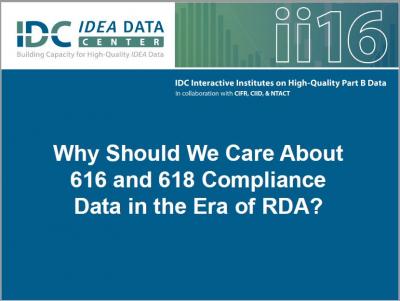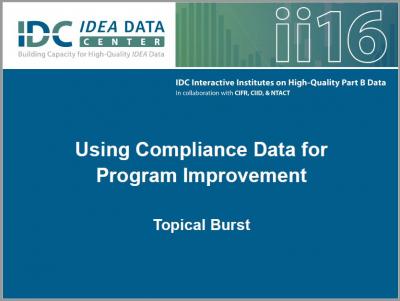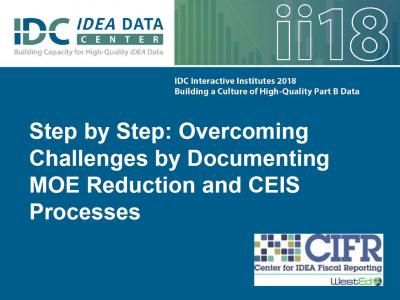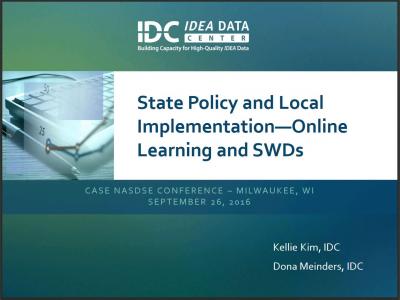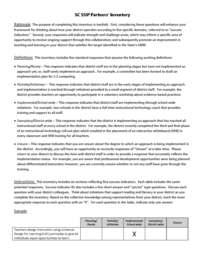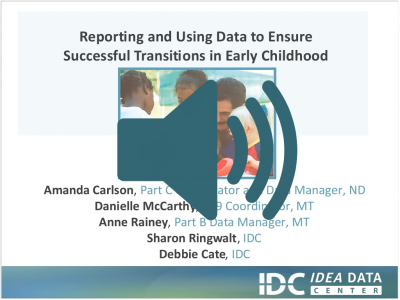Site Search
Results 1 - 7 of 67
Format: Presentations
Why Should We Care About 616 and 618 Compliance Data in the Era of RDA?Some have suggested that RDA and the shift from a focus on compliance to a focus on improving results for children with disabilities appears to have relegated compliance data to the back of the bus. Presenters from the U.S. Department of Education, OSEP highlighted the crucial role that section 616 and section 618 compliance data still play in RDA. Additionally, presenters shared ideas on how these data can be used not only for compliance but also to improve results for children and students with disabilities.
Format: Presentations
Visualizing IDEA DataIDC staff provided an introduction to data visualization approaches that are particularly useful for presenting IDEA data for the public. Participants learned simple strategies, chart types, and report styles that can be used to visualize the state’s data using Microsoft Excel, PowerPoint, and free online tools. Presenters also provided a set of activities so participants can continue developing their capacity in follow-up to the interactive institute.
Format: Presentations
Using Compliance Data for Program ImprovementIt can be challenging to bridge the huge shift from a focus on solely compliance-driven data to an emphasis on results-driven monitoring. Compliance data can be hard and fast; results-driven data can be harder to pin down. This topical burst provided an overview of compliance data, the interrelationship between compliance and results data, and existing processes that can help bridge the gap between accountability and program improvement.
Format: Presentations
Step by Step: Overcoming Challenges by Documenting MOE Reduction and CEIS ProcessesThis workshop explored the benefits of documenting MOE Reduction and CEIS processes for collecting and submitting data to OSEP. Presenters described some of the common challenges that SEAs face with these data. States shared the steps in their processes, who is responsible for the processes, what methodologies they use to collect and review data, and how they consistently validate and report the data.
Format: Presentations
State Policy and Local Implementation—Online Learning and SWDsFindings from IDC’s white paper and interviews of select states revealed that LEAs are responsible for determining LRE and implementation and monitoring of IEPs in online environments. Presentation of findings were followed by a panel discussion of states and LEAs to discuss key problems of practice and needs for resources that IDC can develop to support greater understanding of implications of online learning for SWDs and the relationship to high-quality data.
Format: Guides, Papers, and Reports
South Carolina SSIP Partners’ InventoryAs a part of developing their SSIP Phase I, the South Carolina Department of Education chose to use the IDC Equity, Inclusion, and Opportunity: How to Address Success Gaps, Rubric to inform their work. SC state staff developed the SC SSIP Partners' Inventory by reformatting content in the Success Gaps rubric, breaking apart some of the more complex components of the rubric into more concise elements that could be rated more easily on a Likert-type rating scale.
Format: Recordings
Reporting and Using Data to Ensure Successful Transitions in Early Childhood WebinarThis webinar highlighted the IDEA state reporting requirements for early childhood transitions for both Part C and Part B, found in the SPP/APR Part C Indicator 8 and Part B Indicators 11 and 12. Participants shared resources related to transition, data collection, and reporting, as well as the use of both Part C and Part B data to facilitate high quality transitions. North Dakota's Part C coordinator and data manager and Montana's 619 coordinator and data manager described how their states collect and use transition data to ensure smooth transitions for all young children as they turn three and move from early intervention services to preschool 619 services.

